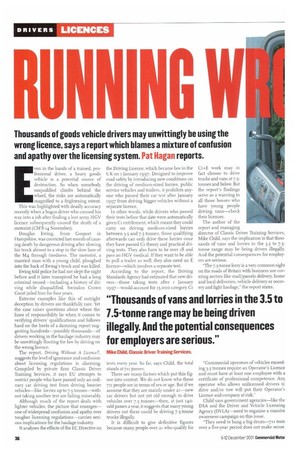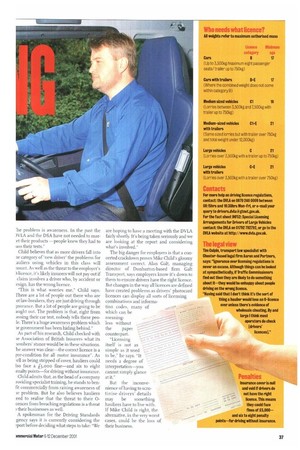RUNNING VI
Page 36

Page 37

If you've noticed an error in this article please click here to report it so we can fix it.
Thousands of goods vehicle drivers may unwittingly be using the wrong licence, says a report which blames a mixture of confusion and apathy over the licensing system. Pat Hagan reports.
Even in the hands of a trained, professional driver, a heavy goods vehicle is a potential source of destruction. So when somebody unqualified climbs behind the wheel, the risks are automatically magnified to a frightening extent. This was highlighted with deadly accuracy recently when a bogus driver who conned his way into a job after Ending a lost army HGV licence subsequently caused the death of a motorist (CM 8-14 November).
Douglas Ewing, from Gosport in Hampshire, was convicted last month of causing death by dangerous driving after slowing his truck almost to a stop in the slow lane of the M4 through tiredness. The motorist, a married man with a young child, ploughed into the back of Ewing's truck and was killed.
Ewing told police he had not slept the night before and it later transpired he had a long criminal record—including a history of driving while disqualified. Swindon Crown Court jailed him for four years.
Extreme examples like this of outright deception by drivers are thankfully rare. Yet the case raises questions about where the lines of responsibility lie when it comes to verifying drivers' qualifications and follows hard on the heels of a damning report suggesting hundreds—possibly thousands—of drivers working in the haulage industry may be unwittingly flouting the law by driving on the wrong licence.
The report, Driving Without A Licence?, suggests the level of ignorance and confusion about licensing regulations is alarming. Compiled by private firm Classic Driver Training Services, it says EU attempts to restrict people who have passed only an ordinary car driving test from driving heavier vehicles—like lorries up to 7.5 tonnes—without taking another test are failing miserably.
Although much of the report deals with lighter vehicles, the picture that emerges— one of widespread confusion and apathy over tougher licensing regulations—carries serious implications for the haulage industry.
It analyses the effects of the EC Directive on the Driving Licence, which became law in the UK on i January 1997. Designed to improve road safety by introducing new conditions on the driving of medium-sized lorries, public service vehicles and trailers, it prohibits anyone who passed their car test after January 19 97 from driving bigger vehicles without a separate licence.
In other words, while drivers who passed their tests before that date were automatically given Cr entitlement, which meant they could carry on driving medium-sized lorries between 3.5 and 7.5 tonnes, those qualifying afterwards can only drive these lorries once they have passed Ci theory and practical driving tests. They also have to be over 18 and pass an HGV medical. If they want to be able to pull a trailer as well, they also need an E licence—which involves a separate test.
According to the report, the Driving Standards Agency had estimated that new dri
vers those taking tests after r January 997—would account for r5,000 category Cr
tests every year. So far, says Child, the total stands at 7H passes.
There are many factors which put this figure into context. We do not know who these 711 people are in terms of sex or age. But if we assume that they are mainly under 2,1—new car drivers but not yet old enough to drive vehicles over 7.5 tonnes—then, at just 140odd passes a year, it suggests that many young drivers out there could be driving 7.5-tonne trucks illegally.
It is difficult to give definitive figures because many people over 21 who qualify for Ci-FE work may in fact choose to drive trucks and vans at 7.5ton nes and below. But the report's findings serve as a warning to all those bosses who have young people driving vans—check their licences.
The author of the report and managing director of Classic Driver Training Services, Mike Child, says the implication is that thousands of vans and lorries in the 3.5 to 7.5tonne range may be being driven illegally. And the potential consequences for employers are serious.
"The 7.5-tonne lorry is a very common sight on the roads of Britain with business use covering sectors like mail/parcels delivery, home and local deliveries, vehicle delivery or recovery and light haulage," the report states.
"Commercial operators of vehicles exceeding 3.5 tonnes require an Operator's Licence and must have at least one employee with a certificate of professional competence. Any operator who allows unlicensed drivers tc drive and/or tow will put their Operator's Licence and company at risk," Child says government agencies—like the DSA and the Driver and Vehicle Licensing Agency (DVLA)—need to organise a massive awareness campaign on this issue.
"They need to bang a big drum-711 tests over a five-year period does not make sense. 'he problem is awareness. In the past the )VLA and the DSA have not needed to mar et their products people knew they had to .ass their tests."
Child believes that as more drivers fall into ae category of 'new driver' the problems for .auliers using vehicles in this class will aount. As well as the threat to the employer's )-licence, it's likely insurers will not pay out if claim involves a driver who, by accident or esign, has the wrong licence, "This is what worries me," Child says. There are a lot of people out there who are ot law-breakers, they are just driving through 4norance. But a lot of people are going to be aught out. The problem is that, right from assing their car test, nobody tells these peole. There's a huge awareness problem which le government has been hiding behind."
As part of his research, Child checked with le Association of British Insurers what its aernbers' stance would be in these situations. 'he answer was clear—the correct licence is a pre-condition for all motor insurance'. As ell as being stripped of cover, hauliers could [so face a £5,00o fine—and six to eight enalty points—for driving without insurance. Child admits that, as the head of a company roviding specialist training, he stands to benfit commercially from raising awareness of ie problem. But he also believes hauliers eed to realise that the threat to their 0cences from breaching regulations is a threat their businesses as well.
A spokesman for the Driving Standards .gency says it is currently considering the Tort before deciding what steps to take: "We
are hoping to have a meeting with the DV LA fairly shortly. It's being taken seriously and we are looking at the report and considering what's involved."
The big danger for employers is that a concerted crackdown proves Mike Child's gloomy assessment correct. Alan Galt, managing director of Dunbarton-based firm Galt Transport, says employers know it's down to them to ensure drivers have the right licence. But changes in the way all licences are defined have created problems as drivers' photocarci licences can display all sorts of licensing combinations and informa tion codes, many of which can be
meaning
less without the paper counterpart.
"Licensing itself is not as simple as it used to be," he says. "It needs a degree of interpretation—you cannot simply glance at it" But the inconve nience of having to scni tinise drivers' details may be something hauliers have to live with.
If Mike Child is right, the alternative, in the very worst cases, could be the loss of their business.
























































































































































